IMDRF/SaMD WG/N12FINAL:2014 Software as a Medical Device Possible Framework for Risk Categorization and Corresponding Considerations - PDF (243kb)
标准简介
Software as a Medical Device Possible Framework for Risk Categorization and Corresponding Considerations - PDF (243kb)[附网盘链接]由IMDRF Software as a Medical Device (SaMD) Working Group于18 September 2014发布,适用于世界。标准截图
![Software as a Medical Device Possible Framework for Risk Categorization and Corresponding Considerations - PDF (243kb)[附网盘链接]](/img/20210914103522czyoi.jpg)
标准文档说明
标准文档类型为Software as a Medical Device Possible Framework for Risk Categorization and Corresponding Considerations - PDF (243kb)[附网盘链接]高清PDF版本(文字版),标准文档内可进行搜索,可以复制原文,可粘贴。标准部分原文
_____________________________________________________________________________________________
1.0 Introduction
Software is playing an increasingly important and critical role in healthcare with many clinical
and administrative purposes.
Software used in healthcare operates in a complex socio-technical environment—consisting of
software, hardware, networks, and people—and frequently forms part of larger systems that must
operate in a unified manner. This software frequently depends on other commercial off-the-
shelf (COTS) software and on other systems and data repositories for source data.
A subset of software used in healthcare meets the definition of a medical device; globally,
regulatory authorities regulate such software accordingly.
Existing regulations for medical device software are largely focused on medical device software
that is embedded in dedicated hardware medical devices and are focused around physical harm,
transmission of energy and/or substances to or from the body, the degree of invasiveness to the
body, closeness to sensitive organs, duration of use, diseases, processes and public health risk,
competence of user and effect on population due to communicable diseases, etc.
Today, medical device software is often able to attain its intended medical purpose independent
of hardware medical devices. It is increasingly being deployed on general-purpose hardware and
delivered, in diverse care settings, on a multitude of technology platforms (e.g., personal
computers, smart phones, and in the cloud) that are easily accessible. It is also being
increasingly interconnected to other systems and datasets (e.g., via networks and over the
Internet).
The complexity of medical device software, together with the increasing connectedness of
systems, results in emergent behaviors not usually seen in hardware medical devices.
This introduces new and unique challenges. For example:
• Medical device software might behave differently when deployed to different hardware
platforms.
• Often an update made available by the manufacturer is left to the user of the medical
device software to install.
• Due to its non-physical nature (key differentiation), medical device software may be
duplicated in numerous copies and widely spread, often outside the control of the
manufacturer.
Furthermore, there are lifecycle aspects of medical device software that pose additional
challenges. For instance, software manufacturers often:
• Have rapid development cycles,
• Introduce frequent changes to their software, and
• Deliver updates by mass and rapid distribution.
_____________________________________________________________________________________________
网盘链接
百度网盘:https://pan.baidu.com/s/1jM4A41Bz6-krKDP-MaH7pA
提取码:e3uq
【温馨提示】大资料ISO是提供信息发布的专业信息类网站,所有内容均由用户发布,不代表本站观点,本站亦不存储所涉及的文件及资料。如有【免费资料】以及【付费资料】,请用户根据自己的需求,自行判断是否需要获取。如有交易诈骗、内容侵权可发送邮件至kf@dzl100.com,我们审查后若发现情况属实,会立即对相关内容进行删除处理。
加载用时:67.5842 毫秒
相关评论
相关文章
-

IMDRF/SaMD WG/N12FINAL:2014 Software as a Medical Device Possible Framework for Risk Categorization and Corresponding Considerations - PDF (243kb)
Software as a Medical Device Possible Framework for Risk Categorization and Corresponding Considerations - PDF (243kb)[附网盘链接]是IMDRF Software as a Medical Device (SaMD) Working Group于18 September 2014发布的GHTF标准,适用于世界。本次分享的标准文档为高清PDF(文字版),标准文档内可搜索,可复制,可粘贴。本文结尾附网盘链接。
-
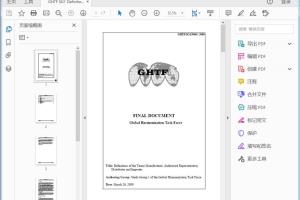
GHTF/SG1/N055: 2009 GHTF SG1 - Definition Terms - Manufacturer - Authorised Representative - Distributor and Importer - PDF (41kb)
GHTF SG1 - Definition Terms - Manufacturer - Authorised Representative - Distributor and Importer - PDF (41kb)[附网盘链接]是Study Group 1 of the Global Harmonization Task Force于March 26, 2009发布的GHTF标准,适用于世界范围。本次分享的标准文档为高清PDF(文字版),标准文档内可搜索,可复制,可粘贴。本文结尾附网盘链接。
-

GHTF/SG3/N18:2010 GHTF SG3 - Quality management system - Medical Devices - Guidance on corrective action and preventive action and related QMS processes - November 2010 - PDF (254kb)
GHTF SG3 - Quality management system - Medical Devices - Guidance on corrective action and preventive action and related QMS processes - November 2010 - PDF (254kb)[附网盘链接]是Study Group 3于4 November 2010发布的GHTF标准,适用于世界。本次分享的标准文档为高清PDF(文字版),标准文档内可搜索,可复制,可粘贴。本文结尾附网盘链接。
-
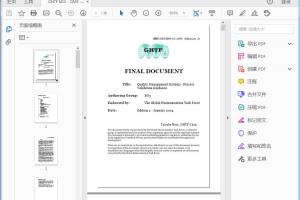
GHTF/SG3/N99-10:2004 (Edition 2) GHTF SG3 - QMS - Process Validation Guidance - January 2004 - PDF (162kb)
GHTF SG3 - QMS - Process Validation Guidance - January 2004 - PDF (162kb)[附网盘链接]是SG3于Edition 2 - January 2004发布的GHTF标准,适用于世界。本次分享的标准文档为高清PDF(文字版),标准文档内可搜索,可复制,可粘贴。本文结尾附网盘链接。
-
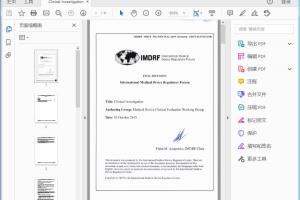
IMDRF MDCE WG/N57FINAL:2019 (formerly GHTF/SG5/N3:2010) Clinical Investigation - PDF (267kb)
Clinical Investigation - PDF (267kb)[附网盘链接]是Medical Device Clinical Evaluation Working Group于10 October 2019发布的GHTF标准,适用于全球范围。本次分享的标准文档为高清PDF(文字版),标准文档内可搜索,可复制,可粘贴。本文结尾附网盘链接。
-
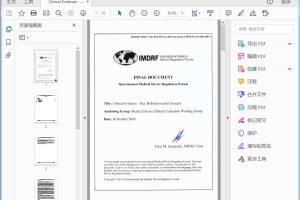
IMDRF MDCE WG/N55 FINAL:2019 (formerly GHTF/SG5/N1R8:2007) Clinical Evidence - Key Definitions and Concepts - PDF (185kb)
Clinical Evidence - Key Definitions and Concepts - PDF (185kb)[附网盘链接]是Medical Device Clinical Evaluation Working Group于10 October 2019发布的GHTF标准,适用于世界。本次分享的标准文档为高清PDF(文字版),标准文档内可搜索,可复制,可粘贴。本文结尾附网盘链接。
-
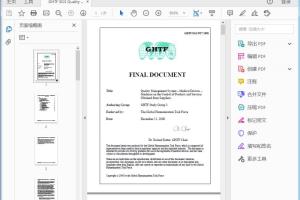
GHTF/SG3/N17:2008 GHTF SG3 - Quality Management System - Medical Devices - Guidance on the Control of Products and Services Obtained from Suppliers - December 2008 - PDF (593kb)
GHTF SG3 - Quality Management System - Medical Devices - Guidance on the Control of Products and Services Obtained from Suppliers - December 2008 - PDF (593kb)[附网盘链接]是GHTF Study Group 3于December 11, 2008发布的GHTF标准,适用于全球范围。本次分享的标准文档为高清PDF(文字版),标准文档内可搜索,可复制,可粘贴。本文结尾附网盘链接。
-

GHTF/SG1/N071:2012 GHTF SG1 - Definition of Terms Medical Device and In Vitro Diagnostic Medical Device - May 2012 - PDF (240kb)
GHTF SG1 - Definition of Terms Medical Device and In Vitro Diagnostic Medical Device - May 2012 - PDF (240kb)[附网盘链接]是Study Group 1 of the Global Harmonization Task Force于May 16 , 2012发布的GHTF标准,适用于世界。本次分享的标准文档为高清PDF(文字版),标准文档内可搜索,可复制,可粘贴。本文结尾附网盘链接。
-
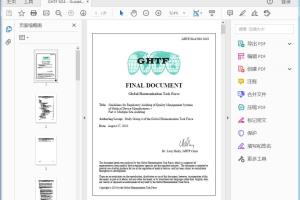
GHTF/SG4/N83:2010 GHTF SG4 - Guidelines for Regulatory Auditing of Quality Management Systems of Medical Device Manufacturers - Part 4 Multiple Site Auditing - August 2010 - PDF (157kb)
GHTF SG4 - Guidelines for Regulatory Auditing of Quality Management Systems of Medical Device Manufacturers - Part 4 Multiple Site Auditing - August 2010 - PDF (157kb)[附网盘链接]是Study Group 4 of the Global Harmonization Task Force于August 27, 2010发布的GHTF标准,适用于全球。本次分享的标准文档为高清PDF(文字版),标准文档内可搜索,可复制,可粘贴。本文结尾附网盘链接。
-

IMDRF/GRRP WG/N47 FINAL:2018 Essential Principles of Safety and Performance of Medical Devices and IVD Medical Devices - PDF (260kb)
Essential Principles of Safety and Performance of Medical Devices and IVD Medical Devices - PDF (260kb)[附网盘链接]是IMDRF Good Regulatory Review Practices Group于31 October 2018发布的GHTF标准,适用于世界。本次分享的标准文档为高清PDF(文字版),标准文档内可搜索,可复制,可粘贴。本文结尾附网盘链接。
-
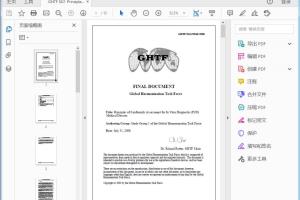
GHTF/SG1/N046:2008 GHTF SG1 - Principles of CA for IVD Medical Devices - July 2008 - PDF (87kb)
GHTF SG1 - Principles of CA for IVD Medical Devices - July 2008 - PDF (87kb)[附网盘链接]是Study Group 1 of the Global Harmonization Task Force于July 31, 2008发布的GHTF标准,适用于全球范围。本次分享的标准文档为高清PDF(文字版),标准文档内可搜索,可复制,可粘贴。本文结尾附网盘链接。
-

GHTF/SG2/N79R11:2009 GHTF SG2 - Medical Devices Post Market Surveillance - February 2009 - PDF (142kb)
GHTF SG2 - Medical Devices Post Market Surveillance - February 2009 - PDF (142kb)[附网盘链接]是Study Group 2于February 17, 2009发布的GHTF标准,适用于世界。本次分享的标准文档为高清PDF(文字版),标准文档内可搜索,可复制,可粘贴。本文结尾附网盘链接。
-
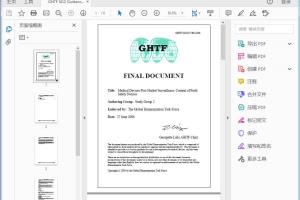
GHTF/SG2/N57R8:2006 GHTF SG2 - Guidance - Content of Field Safety Notices - PDF (58kb)
GHTF SG2 - Guidance - Content of Field Safety Notices - PDF (58kb)[附网盘链接]是Study Group 2于27 June 2006发布的GHTF标准,适用于全球。本次分享的标准文档为高清PDF(文字版),标准文档内可搜索,可复制,可粘贴。本文结尾附网盘链接。
-
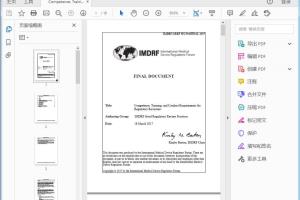
IMDRF/GRRP WG/N40FINAL:2017 Competence, Training, and Conduct Requirements for Regulatory Reviewers - PDF (174kb)
Competence, Training, and Conduct Requirements for Regulatory Reviewers - PDF (174kb)[附网盘链接]是IMDRF Good Regulatory Review Practices于16 March 2017发布的GHTF标准,适用于全球。本次分享的标准文档为高清PDF(文字版),标准文档内可搜索,可复制,可粘贴。本文结尾附网盘链接。
-
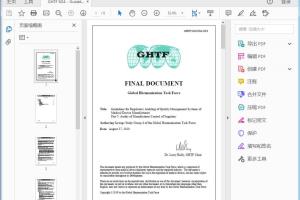
GHTF/SG4/N84:2010 GHTF SG4 - Guidelines for Regulatory Auditing of Quality Management Systems of Medical Device Manufacturers. Part 5 Audits of Manufacturer Control of Suppliers - August 2012 - PDF (96kb)
GHTF SG4 - Guidelines for Regulatory Auditing of Quality Management Systems of Medical Device Manufacturers. Part 5 Audits of Manufacturer Control of Suppliers - August 2012 - PDF (96kb)[附网盘链接]是Study Group 4 of the Global Harmonization Task Force于August 27, 2010发布的GHTF标准,适用于世界范围。本次分享的标准文档为高清PDF(文字版),标准文档内可搜索,可复制,可粘贴。本文结尾附网盘链接。